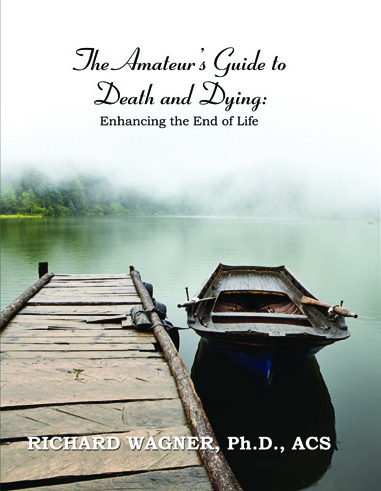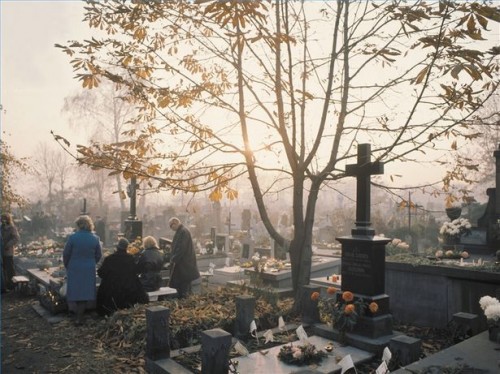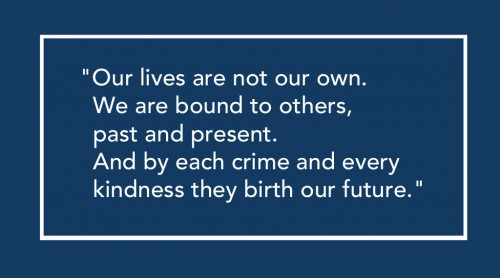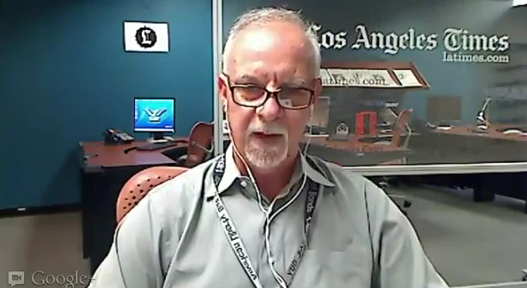The GroundSwell Project Review
More marvelous news! The second amazing review of The Amateur’s Guide To Death and Dying; Enhancing the End of Life has appeared in as many days.
The Amateur’s Guide to Death and Dying
Review by Emilie Collyer
‘None of the hard times I’ve seen, and I’ve seen plenty, lasted forever. Even this dying business will be over one day. I’ll just wake up dead one morning and that will that. What can I tell you?’
So says Max, an 86 year old man dying from stomach cancer. He’s one of ten group members you’ll meet and get to know when reading The Amateur’s Guide to Death and Dying.
The book is written by Richard Wagner who runs a non profit organisation called PARADIGM Programs Inc whose mission is ‘enhancing the end of life’. One of the main initiatives of the organisation is a ten week structured support program that focuses on death and dying. It is primarily targeted at people diagnosed with a terminal illness, but anyone can do the course.
The Amateur’s Guide to Death and Dying is a ‘workbook’ that takes the reader through the course. There are ten chapters that cover a wide range of territory. It is presented as a combination of group sessions, homework tasks and reflection exercises. There is a detailed blurb about each person and from then on we ‘hear’ from them in the first person, as if they are speaking directly to us in a group situation. They are fictional creations, but based on amalgams of real people. Wagner evokes their personalities well. I felt like I was hearing from ten distinct voices.
The content is comprehensive. We start with a discussion about perceptions of death, including why it still seems to be a taboo subject for so many people. Raul, 18, has polycystic kidney disease. He says how sick he is of ‘fightin’ something I can’t win.’ He hasn’t told his parents about attending the group because he knows how scared they are to accept the fact that he won’t live a long life: ‘They want me to keep praying to all these saints for some kinda stupid miracle. There are so many saints I can’t even remember all their names.’
From there, chapters move through many subjects and tasks including: writing your own obituary, legal, medical and financial matters, sexuality and body image for people who are dying, spirituality and belief, what happens to the body when we die, and the question of assisted, or pro-active dying.
The book is not always an easy read. It opens up questions about our own lives, including regrets and lost chances: ‘I haven’t done anything extraordinary, never won an award, never had my picture in the paper, never went to college, never even had a real job. I’m just an old woman who hasn’t anything to show for her life. And that makes me sad,’ says Janice, 62.
Reading such personal and intense stories has a significant emotional impact. I had to read slowly and take time out on occasion. And of course each story, task and provocation is designed to bring to the surface our own fears, hopes and regrets about death. This is a stated goal of the book and Wagner’s work in general. He is seeking a radical shift in how we perceive dying, specifically in terms of integrating it more consciously into every day life.
It’s not just about increasing awareness. Wagner believes we can live more full lives by embracing death. One of his motivations for creating the program and the book was because: ‘… the wisdom people come to during the dying process often died with them. There simply wasn’t a medium for collecting this abundant wisdom and thus it was frequently lost.’
There is a satisfying narrative arc to the book. Each of the participants comes to a sense of peace and acceptance about their situation. Many have renewed hope and vigour. ‘I feel like I’ve been able to look death in the face these past ten weeks and I didn’t flinch. So maybe, just maybe, death is not so foreboding after all,’ says Kevin, 39.
Some of the final statements in the evaluation section are a little pat. The book allows a neatness and sense of conclusion that is generally lacking in life with all its messiness. This is a minor point though, as the book’s content never shies away from the difficult and the unresolved.
The Amateur’s Guide to Death and Dying is a useful and practical tool for any person approaching their own death, or the death of a loved one and would make a valuable resource for health and community organisations working in this area.
Spending focussed time meditating on the end of life is not something we do often. It’s confronting to face our own mortality, but there’s something vital, even exhilarating about the brief moments of insight that can come. I’d recommend The Amateur’s Guide to Death and Dying to anyone seeking to engage with questions about death and the meaning of life.
Full Review HERE!
Los Angeles Times chat: Columnist Steve Lopez on death with dignity
Take Control Of Life, Death
By Dr. Aroop Mangalik
If you want to be comfortable, happy and be with your family and friends when you are facing a serious illness or are likely to die in the near future, you need to take control.
 In recent decades, there has been what some have called “medicalization of death.” There have been many advances in medicine and a lot of people are living healthier, longer lives.
In recent decades, there has been what some have called “medicalization of death.” There have been many advances in medicine and a lot of people are living healthier, longer lives.
But ultimately, we all have to die.
Medicalization of death has occurred, to a significant degree, because we – society, patients and doctors – have not taken into account the fact that there are limits to life and that medical interventions can only do so much.
Understanding this reality is a major step that must be taken to get the best outcome for the patient.
How does one understand this? How do we take control of the situation?
The knowledge you need to get will necessarily come from your medical provider. The best decisions are made by having the facts – available treatment options and the likely outcomes.
Ask your provider about the nature of the illness and what is expected without any treatment.
The next steps will be to get a clear picture of what treatments are available. You should be able to get some idea of how likely it is that the treatments will improve the outcome for you.
This includes information on previous success and failures with available options. At least try to find out if the treatment is “very likely,” “likely,” or “not likely” to help.
Equally, important, you need to know what will be the side-effects of treatment. Will the treatments be harsh or mild, will they last for a short time or will they be persistent.
The cost in dollars is also something that must be considered. In this day of uncertainty we cannot ignore that factor. Many families face bankruptcy because of “long shot” medical treatments.
Once you have the information, you need to decide. It should be your decision based on the best information and input you can get.
If you feel that the treatments available to you are not going to help you achieve your goals, you can refuse those treatments. No one can force you to have a treatment you do not want.
If you choose the path of not taking the treatment, the focus changes from controlling the disease to making your life as comfortable as possible.
The medical team will work with you to control your symptoms. They will help you with pain control, nausea, vomiting, shortness of breath or difficulties in performing day-to-day activities. They will work with you to get the best out of life for whatever time you are alive.
There are many types of experts who are trained to help you. They have overlapping roles and expertise and they work together.
They are referred to as Palliative Care Specialists, Hospice Teams or Symptom Management experts. They all have the goals of making your life better and focus on you.
They also help you and your family so that you die comfortably and with dignity with your family and friends around you.
In certain circumstances, despite their efforts, living may feel like a burden. There are other options that can be utilized.
This is the option of you willfully ending your life at the time you choose. This option has been given a number of names. Physician-assisted death (and) assisted suicide being two common ones.
The option is currently available in Oregon and Washington State. In New Mexico, we are waiting for the courts to decide if such an action would be legal.
In summary, when faced with a serious illness, you should take control of your life and decide what is best for you.
Complete Article HERE!
Meditation – RECONSTRUCTING THE CHANGING FACE OF DEATH, Part 2
RECONSTRUCTING THE CHANGING FACE OF DEATH, Part 2
— Charles Corr
Humans strive to influence or control nature and the natural patterns of events around them.
Another prominent chance in our mortality patterns has to do with the location or place of death. By 1949 approximately 50% of the deaths in the United States took place in an institution. By 1958 institutionalized deaths had risen to just over 60%. Now, 70-80 percent of deaths in our society occur in an institutional setting.
 Locating death in institutions is a major social change from those times when death ordinarily occurred at home. It means that death is removed in one more way from the midst of our lives. This tend to segregate death from the rest of society. As a result, individuals in our society are now much more likely to die alone, in unfamiliar surroundings, or amongst strangers than they are to die at home in the company of those they love.
Locating death in institutions is a major social change from those times when death ordinarily occurred at home. It means that death is removed in one more way from the midst of our lives. This tend to segregate death from the rest of society. As a result, individuals in our society are now much more likely to die alone, in unfamiliar surroundings, or amongst strangers than they are to die at home in the company of those they love.
This has important and often negative implications for the way dying will be experienced, for survivors, and for the institutions into which death is increasingly thrust, especially if many of those institutions view themselves as “health centers”. In such institutions dying is very likely to be regarded as an unhealthy or undesirable thing to do.
Whereas death has become less erratic and mysterious, more predictable and understandable at the objective level, it is also increasingly an experience that has grown apart from the mainstream of every day life.
Death has become less natural and familiar to us and thus increasingly appears to be less appropriate as a part of a person’s lot in life.
The more the natural death of human beings becomes a less familiar part of our lives, death achieves a startling prominence as an insubstantial fantasy in the mass media and popular culture. Death is staple fare of popular entertainment fantasies. A perverse feature of the cowboy, police, medical and adventure stories depicted on television and in the movies.
We are bombarded with images of death that are apart from and inconsistent with the realities of life. This leads to an even more distorted image of death.
“Tamed death” Life and death were close companions. Death was both familiar and near, a customary fact of human destiny. Tame death was often sad and painful, but it did not appear to threaten the regular order of life’s events as death often does at present.
“Decent Interval” of dying gave the individual and opportunity to assemble family, set important affairs in order, dispose of property, and “prepare to meet the Maker”. The cult of the ars moriendi the “art of dying” encouraged calmness, solemnity, and a sense of awe. Death could be a high point of life. Death is a culmination in which the individual is a full and often dominant participant, and it results in a loss that is not without its consolations for one’s survivors.
“Break with life” or rapture frightening yet obsessive. What was once ordinary or even banal turned into an object of morbid attention.
“Forbidden Death” shameful and prohibited. A pair of misconceived ingredient: depriving the individual of the truth about death’s imminence and the misplacing of the burden on someone other than the dying. All dependent upon an increasingly negative attitude toward death and its implications.
We know in a abstract intellectual way that death is a general fact of life, but the specific event becomes so unusual that it is regarded as quite unreal.
Socialization process mirrors attitudes. death becomes less and less frequent part of our life. False sense of security grows in its fading presence. Death not really a legitimate part of life, regarded as unfortunate, undesirable, and even improper. Increasing distance coupled with decreasing frequency
Responsibility for the sick, elderly, dying and the dead given to select set of institutions and professional functionaries.
Like all disgusting subjects, death can only be introduced into polite conversation obliquely or euphemistically.
A dying person become a “patient” a revealing label– passively enduring, waiting calmly and undergoing care, receiving treatment from another.
the mobilization of a wide range of equipment technical skills and other resources to combat illness and death.
A narrow range of attitudes dictate the perspective of how individuals ought feel, behave and what society will tolerate.
Part 1 HERE!
What waiting for death has taught me
By — Bill Tammeus
I’ve been here in soft, green New England learning patience and waiting for death.
Not my death, but that of my wife’s sister, who early this year entered her fourth year of living with the dark and vicious stranger called ovarian cancer. It is cellular evil, a parasitic wanderer that will invade more than 22,000 women this year, while killing more than 15,000 previously diagnosed women, including Leslie. Worse, the American Cancer Society reports that the mortality rate for ovarian cancer has not improved in 40 years.
 No one expected Leslie to last this long after — several weeks ago — her excellent oncologist abandoned the idea of dreaming up exotic defenses and sent her home to await the inevitable.
No one expected Leslie to last this long after — several weeks ago — her excellent oncologist abandoned the idea of dreaming up exotic defenses and sent her home to await the inevitable.
But three weeks after my wife flew up here to be with her and most of a week after I joined her, Leslie continues to be in a hospital bed in her home and to be tended to by family, by visiting nurses and by hospice workers.
When her eyes are open, I can see in them resignation, then her usual mirth and then what sometimes looks to me like terror. I don’t really know if it is terror, however. Leslie hardly speaks any more, and when she did speak, I heard no terror in her tone or words. So maybe I’m simply imagining it. Maybe the terror is in me as I look at her frail, jaundiced body.
What I am not imagining, however — what, in fact, is brutally clear to me — is that death arrives not on our schedule, but on its own. It will not be hurried, this thief, and yet neither will it be delayed by our hopes, our longings, all our spoken and unspoken prayers and dreams and demands tossed at God.
Death came for my nephew in a luminous flash of vindictive explosiveness the morning of Sept. 11, 2001, as he occupied seat 20-J of American Airlines Flight 11 from Boston to Los Angeles, with a permanent detour to the World Trade Center in New York.
No one was prepared for that. No one wanted death then.
No one was prepared for the death of Leslie’s own mother when Janet was just 47, either. But a cerebral hemorrhage brought her down in a matter of a few blindingly astonishing hours. So when Leslie turned 47, she could hardly wait to be 48 and not repeat her mother’s terrible fate.
Now, by contrast, every member of Leslie’s big family has become accommodated to death’s impending arrival. So we simply wait by her bedside or feed ourselves or work in the yard or tend to Leslie’s two infant grandchildren, Evie and Jack, or read or take walks or check our email or pray or hug each other.
And yet death keeps its own stealthy schedule, so the homily I’ve prepared at Leslie’s request to give at her funeral remains unspoken.
And our lives tread water.
But who are we to imagine that we are in charge of the large questions of life? Suicide or murder aside, we have no say in when death arrives just as we have no say in who will love us or when it will rain.
It is only our foolish arrogance that lets us think otherwise.
So, in the end, we have a choice. We can continue to pretend we control life’s major turnings or we can trust, with Julian of Norwich, that in the end, “all shall be well, and all shall be well and all manner of things shall be well,” because we trust in a God who wants the best for us.
My head knows all that. But my heart rebels, wanting what I imagine is best for Leslie to happen now and not later.
* * *
Author’s note: Leslie died the evening of July 9. And we are impoverished by her absence.
Complete Article HERE!
Talking with teens about death
Study finds that seriously ill young people want to discuss their care, wishes — Barbara Brotman
It is the hardest conversation a parent can imagine: talking to a critically ill child about the possibility of death.
But Deb Fuller, of Woodstock, wishes she had done it sooner.
 By the time she and her husband broached the subject with their nearly 13-year-old daughter, Hope, her brain cancer was so advanced that she could barely speak.
By the time she and her husband broached the subject with their nearly 13-year-old daughter, Hope, her brain cancer was so advanced that she could barely speak.
Fuller asked Hope if she was afraid; if she was worried about how her parents and brother would cope when she was gone; if she was ready to go anyway.
Hope answered by squeezing her mother’s hand: Yes. Yes. And yes.
“That ended up being one of the best nights we had,” Fuller said. “We all sat around together to the wee hours of the morning and talked.
“But I waited too long. I thought we had more time,” she said.
Hope died within days.
“I wish she could have spoken to me,” she said. “I hate the thought that perhaps she laid there … and worried about it, unable to talk to me about it.”
End-of-life experts say that children should have the opportunity to discuss death in a developmentally appropriate way with a parent or a knowledgeable adult, though such conversations should not be forced.
And a recent study shows that many seriously ill children want to have that talk, and that both they and their parents are relieved afterward.
But parents often don’t know how to begin an end-of-life conversation with their children, said Maureen Lyon, associate research professor in pediatrics at Children’s National Medical Center in Washington and principal investigator at its Children’s Research Institute.
They are often afraid that talking about death will be harmful to the child, Lyon said. And by the time teenagers enter hospice or palliative care programs, which are adept at such conversations, the youths may be too ill to be able to talk or not want to at all.
But it can be a crucial conversation, Lyon said. Important decisions may have to be made, like whether to discontinue aggressive medical treatment or whether they would want to die at home or in a hospital.
Too often, no one — not even doctors — asks these questions of seriously ill teenagers themselves, she said. Without knowing their children’s wishes, families can be torn apart by conflict. And though youths under 18 have no legal standing to direct their medical care, Lyon said, their opinions should be heard.
She and Linda Briggs, associate director of the Respecting Choices program at Gunderson Health System in La Crosse, Wis., designed a way they can be.
They conducted a study in which they used facilitators to guide seriously ill young people and their families through conversations about end-of-life care — the same kind of conversations Respecting Choices offers to adults. At the end, the teens filled out advance directives outlining their wishes.
The study, which Lyon and Briggs presented at the annual conference of the International Society of Advance Care Planning and End of Life Care held recently in Rosemont, found that the youths wanted to be consulted, parents wanted to know their children’s thoughts and both teenagers and their families found the experience worthwhile.
Moreover, the conversations did not cause harm. The young people — who were between 14 and 21 and had either HIV or cancer — were no more anxious and depressed after they talked.
“The assumption is that these conversations will take away hope and raise anxiety. The reality is the opposite,” Briggs said.
Not that the conversations were entirely pain-free.
“The study was much harder on the teens with cancer,” Lyon said. A small percentage of those youths said they had found the talks hurtful. However, they also found them worthwhile. Lyon hypothesized that because they were more ill than the HIV-positive youths, the possibility of death was more real.
But Jessica Gaines, 22, who participated in the study as an 18-year-old who had been treated for Hodgkin lymphoma, said she was glad to be finally asked her opinion.
“When I was going through treatment, I was never asked, ‘Well, what happens if you don’t make it through?'” said Gaines, who lives outside Washington.
Parents were appreciative of the talks too. “I feel like a load was lifted,” one commented in a survey.
Some teens and families declined to participate. Hospices, too, find that not everyone wants to have such talks.
Jeremy Campus, 13, of the Northwest Side, is battling cancer that has recurred a third time. A patient at Hospice and Palliative Care of Northeastern Illinois, Jeremy is well aware of the gravity of his condition. His mother, Annmarie, has let him know that she is available to talk about anything, and his palliative care team is similarly open.
But when it comes to addressing the worst possibility, the quiet-voiced boy sitting at his family’s dining room table is clear.
“I don’t want to talk about it,” he said.
Some parents don’t want their children to talk about it.
“I was against, until the last breath of my son, for anybody to even to mention the word death to him,” said Alla Lyubyezny, of Buffalo Grove, whose son, Max Stine, died of brain cancer five years ago. He was 17 and a patient at Horizon Hospice and Palliative Care.
She didn’t want Max to lose hope, and considered it her duty to protect him from the pain of confronting death.
“Nobody needs to have this information, and to live their last, the month of time that is left to them, with that,” she said. “There are some subjects that are best left alone.”
But children generally know how sick they are, said Jennifer Misasi, head of Horizon’s pediatric program. They sometimes avoid talking about it to protect their parents, she said.
And there is no evidence that talking about impending death in a sensitive and appropriate way takes away children’s or parents’ hope or leaves them devastated, said Dr. David Steinhorn, medical director of the palliative care program at Chicago’s Lurie Children’s Hospital.
“Parents who have the opportunity to have frank conversations in a supportive, open way actually do much better and have fewer regrets when their child is dead than parents who do not talk about it,” he said.
“We’re not saying this should be imposed on anybody,” Lyon said. “But for those teens that want to have a voice, this works.”
“This isn’t about ‘Do you want CPR, yes or no,'” Briggs said. “It’s having them express their goals and values.
“How would you want your mom to make decisions for you? What would you want your mom to know about what kind of life makes sense to you, and what kind of life doesn’t make sense to you?”
Complete Article HERE!



